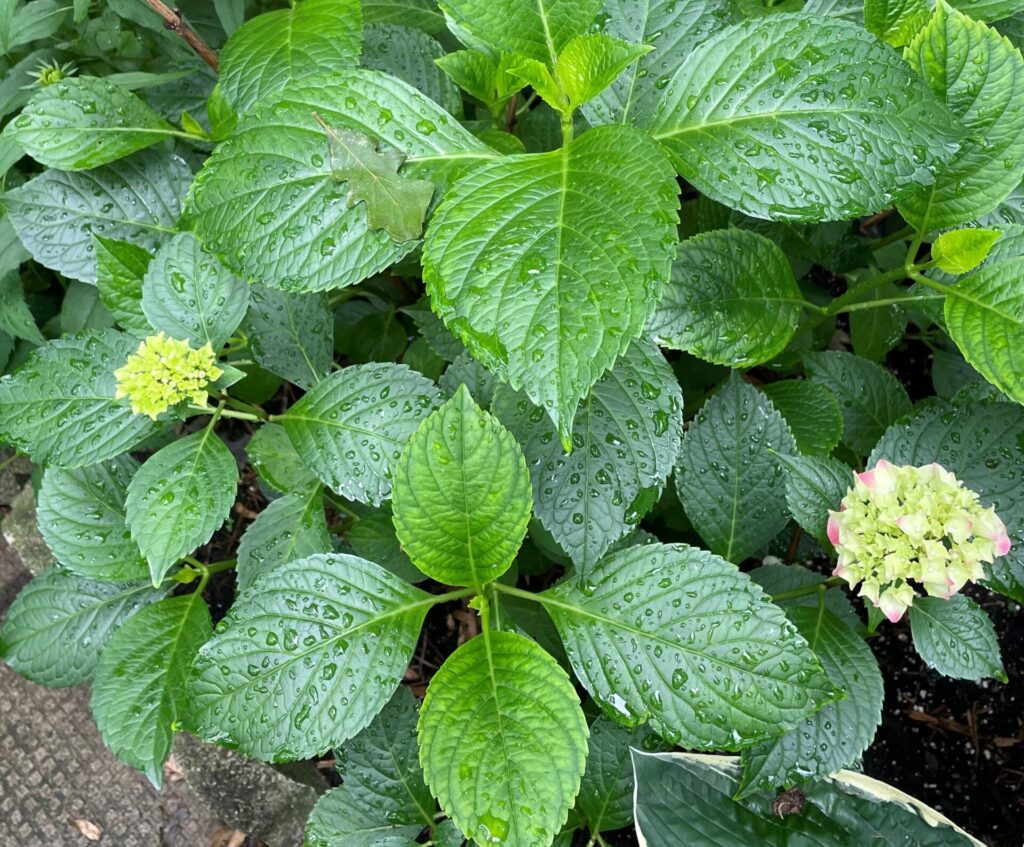
Hello,
I first planted this hydrangea with flowers possibly 2014 (not full sun), then I transferred the plant to other place (not full sun) in 2018. Since then I have never seen flowers… if there was, only one or two flowers in one summer.
So I’m very happy to see two flowers now!
My questions:
– Is it normal that the plant takes 5 years to establish in a new place?
– How to maintain successfully?
e.g. 1. When to prune/ how to prune (I searched, but information varies…)
Thank you for contacting the Toronto Master Gardeners about your hydrangea. Below is a comprehensive Guide about caring for hydrangea written by Toronto Master Gardeners:
It’s important to identify the type of hydrangea you have in your garden. The leaves in the photo you submitted could be from either Hydrangea arborescens ‘Annabelle’ or Hydrangea macrophylla (commonly called Bigleaf Hydrangea and “mophead”). The leaves of arborescens are heart shaped, thin and floppier than Bigleaf. Their surface is matte and of a coarse texture. Hydrangea arborescens ‘Annabelle’ have unmistakable giant white bloom heads.
Leaves from macrophylla are smooth and the leaf stems are long and hold the leaf away from the main stem. Your photo shows a pink edge to one of the blooms and often macrophylla have distinctive pink or blue flowers.
Below is a link to advice on Big Leaf Hydrangea. Big Leaf Hydrangea in blue and pink are often for sale in corner stores in early spring after their blooms have been forced in a green house.
To answer your questions:
- Any plant takes time to re-establish after transplanting. In our Toronto climate, most hydrangeas need sunlight to expand their root systems, grow adequate leaves and produce blooms. Adequate watering is necessary, but for blooms, sunlight is key. Is it possible to clear any branches from overhead trees to allow more light to access your plant? Nearby tree roots can adversely affect hydrangea root systems. Transplanting twice may have caused root damage and that takes years to rebuild.
- Spring and winter conditions affect bloom cycle and some years, hydrangea may not produce flowers. Drought in summer can influence the plant in the next season. The longer the plant has to establish, the more likely it is to have the strength to produce flowers.
- The correct fertilizer added to the soil in spring can encourage bloom growth, particularly if you have Hydrangea macrophylla that feature blue or bright pink blooms. Blue blooms enjoy acidic soil and aluminum sulfate is used to achieve that blue colour. Pink flowers need alkaline soil and lime can be added for pink blooms. A word of caution here – feeding with a high Nitrogen (N) fertilizer will produce vegetative growth at the expense of flowering and this goes for nearby lawn fertilization or anything within close proximity to your flower beds.
- After determining what type of hydrangea you have, maintenance and pruning depend on whether it blooms on old or new wood. Bigleaf hydrangea bloom on old wood so should be pruned in the spring when you can see the new growth appear. The old blooms can add interest to your garden in the winter.
- If your hydrangea turns out to be a Hydrangea arborescens ‘Annabelle’, this plant blooms on new wood and can be cut to a height of 6 – 8 inches in the fall. Again the dried flowers look great in a winter garden, and pruning can be left to the spring.
See the links below for more reading:
Watch your hydrangea this summer to see if you can identify its type. Then the issues of sunlight, fertilizer, pruning and bloom type can be addressed. Good luck with learning about and enjoying your hydrangea.

